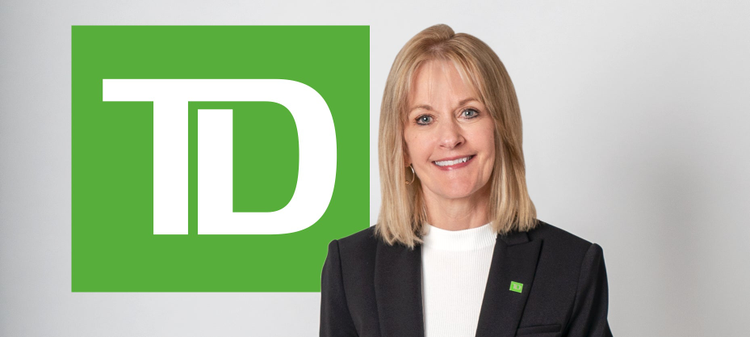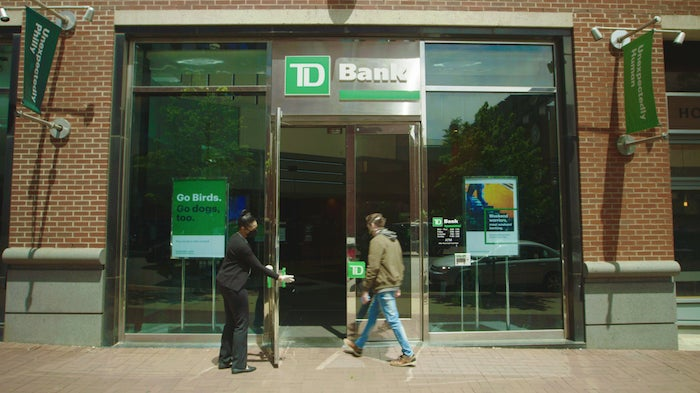TD Bank CMO: Communication, empathy, and transparency key to leadership during crisis

Financial institutions, like many companies in other sectors, had to quickly adapt to supporting the needs of their employees and customers in what became an almost exclusively digital world when the COVID-19 pandemic first hit the United States in March.
For TD Bank, one of the nation’s 10 largest banks, a deep understanding of customers, as well as empathy and transparency for employees, has been a winning formula for success during this time of unprecedented uncertainty.
In this exclusive interview with Tyrrell Schmidt, CMO of TD Bank and head of global brand for TD Bank Group, we learn about what the pandemic has taught her about leadership, business, hiring, and managing employees.
What makes TD different than other banks?
It’s the people. We truly have a culture that values its colleagues. It’s built on a foundation and culture of caring, which I think is unique and makes people want to come to work at TD and want to stay with us.
The other thing that sets us apart is our deep belief in customer-centricity. We put the customer at the center of all of our decisions, including how we think about bringing our brand to our communities.
For example, in the U.S., one of the key pillars or tenets of our brand is knowing and being part of our local communities. So, whether that’s knowing the small businesses that are there or having a strong local field marketing team who brings our brand to life in our communities, it’s a core differentiator.

TD Bank serves more than 6.5 million customers with a network of more than 1,241 branches in the United States.
What has COVID-19 taught you about your customers?
It’s truly an extraordinary time. I think the one thing that I would mention is how important it is to deeply understand our customers and their needs. We’ve spent a lot of time with customer insights and really understanding the evolving consumer mindset during this unprecedented time. And that has helped us as we’ve both looked at some of the challenges, but also where we’ve found some opportunities.
For example, we’re seeing a cautious consumer sentiment and some COVID message fatigue. So, we’ve been paying attention to consumers in terms of what is it they are ready to hear and that they want to hear. The result is balancing optimism with a sense of realism, while recognizing and helping to address the challenges that many of our customers are experiencing.
With so many brands clamoring for attention, what do you believe is key to breaking through to consumers at this time?
Consumers were bombarded with thousands of different messages every day pre-pandemic. Now, with screen time up and everybody marketing through digital, breaking through is even more important. In order to break through, you need to be both meaningful and relevant at the same time. That means paying close attention to consumer mindset.
We think it’s more important than ever before to be able to show empathy and provide clear direction to keep our customers and colleagues safe and healthy and financially healthy as well. At the same time, we also want to bring this kind of unexpectedly human jolt of joy to a trying time. And that’s how the brand is being delivered today — understanding and empathizing with customers but doing it in a way that is quite joyful.
Does creativity play a role in getting customers to hear you?
Absolutely. Strong creative assets are a must, especially given the message proliferation we just discussed. We have a unique brand in the market, and we go to market differently than many of our competitors – both in terms of our brand promise of Unexpectedly Human as well as our community orientation – which gives us an advantage.
We’ve also had to be creative with how we do production during COVID. As an example, in May we launched a video ad called “Dance from Home,” which was based on a television spot that we previously ran. We tailored the message to encourage our customers to bank from home through digital channels. It’s clear that to break through, we have to continue to evolve our messaging in order to stay relevant.
Where do you see marketing budgets shifting in the next few months?
It’s an interesting time for marketing budgets overall. Going back to the “Dance from Home” ad, that was actually shot using an iPhone. We didn’t have a big crew film it. COVID has caused us all to adapt to new ways of thinking. There will be some benefits from that that will be long lasting.
I also think that marketers will continue to be incredibly focused on delivering digital content. We are seeing searches for financial advice accelerating during the pandemic. And we are really focused on being there with the customer as they go on their journey and providing relevant content every step of the way. To take it a step further, delivering personalized content throughout the marketing funnel is going to be meaningful and relevant and where I think companies will continue to invest.
There’s a heightened emphasis on technology right now because it solves a lot of the problems of bringing some of those traditionally in-person engagements to digital channels. Is there an emerging technology that you’ve recently implemented to better engage with customers during the pandemic?
We just launched a chatbot on our website to give customers the opportunity to interact with us in a digital format. In general, we are trying to find technologies that we can invest in that create an omnichannel experience where our customers receive that human experience no matter how they’re interacting with us.
What are some of the biggest challenges you think brands might face in 2021?
One of the biggest challenges will just be the uncertainty. For example, we often lean on sports and music sponsorships where we bring large groups of people together. At this point we don’t know when we will be able to do live, in-person events. There’s also uncertainty around a second COVID wave. I think being flexible and agile in terms of how you go to market is going to be crucial next year.
How can brands and marketing teams be more agile?
Even pre-pandemic, TD was already on a journey to make our marketing organization more agile. We’ve learned that having a cross-functional team and empowering them to make decisions to get things done quickly on behalf of our customers and colleagues is paramount.
Additionally, having the ability to actually get everybody working from home is crucial to staying agile. Finally, being mindful of each other and deeply understanding your colleagues’ situation also drives agility, and it’s something that we’re paying a lot of attention to right now.
Do you think that COVID-19 is going to change the way that you hire and manage your people?
As we look at how quickly technology is accelerating and plans are shifting, we’re constantly focusing on redeploying, upskilling, and reskilling people. We have some great examples of that during COVID. At one point we had a lot of social media queries coming in, so we trained marketers in social customer service to adapt and better support our customers, which was our top priority.
In terms of hiring, I myself will be looking for people who can adapt and who fit the culture that we have, which is such an important part of who TD Bank is.
What’s the biggest business lesson you learned from COVID-19?
I would ladder it back up to our company’s purpose: to enrich the lives of our customers, our colleagues, and our communities. And it’s truly what has been our North Star. It always has been, but even more so during this time. Really thinking about the lives of those three critical stakeholders and making sure you are that caring, empathetic company in how you show up to enrich their lives is paramount.
Any COVID-19-related leadership tips for our readers?
I think there are a couple of key things. One is, communicate. We’ve always heard that, but it’s even more pronounced now. Keeping people connected on what’s happening with the business and what different teams are doing is important. You need to create connections for people; that’s meaningful right now.
Also, just checking in with individuals who are all balancing different things is important, too. You have moms and dads with kids, people caring for their elderly, and even people who are living alone who don’t have interaction, yet they require it. By sharing your own personal journey during COVID, and we all are adapting to something, I think it gives people the permission to speak about what they need. And that is really important.